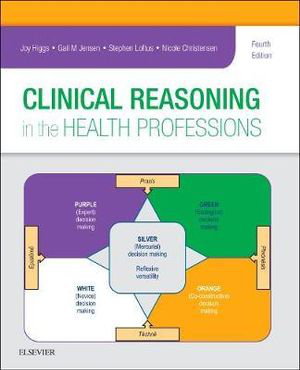| Fri | 9am – 5:30pm |
| Sat | 10am – 5pm |
| Sun | 12pm – 4pm |
| Mon | 9am – 5:30pm |
| Tue | 9am – 5:30pm |
| Wed | 9am – 5:30pm |
| Thu | 9am – 5:30pm |
Ask our staff anything about our shop or products, or share your feedback.

PublishedElsevier, October 2018 |
ISBN9780702062247 |
FormatSoftcover, 532 pages |
Dimensions23.5cm × 19.1cm |
Clinical reasoning lies at the core of health care practice and education. Clinical Reasoning in the Health Professions, therefore, occupies a central place in the education of health professionals, the enhancement of professional decision making of individuals and groups of practitioners with their clients, and research into optimal practice reasoning.
Key themes presented:
Clinical reasoning as a composite of encultured capabilities
Clinical reasoning embedded within situated practice including the wider socio-economic and political contexts, the practitioner's and the client's contexts, and shared goals such as promoting health communities
The importance of narratives, language and culture in clinical decision making
Changing reasoning practices linked to increasing autonomy of practitioners working without the requirement of medical referrals
Clinical reasoning as an increasingly team-based practice, including shared decision making with clients
The need for sound strategies and tools to facilitate the expanding collaborations in health care across disciplines and with clients and carers
Advanced education approaches promoting expansion and enhancement of reasoning strategies
The importance of building good practices for learning clinical reasoning into curricula and into students' own practice development approaches
Strengthening links between orthodox and complementary medicine reasoning practices
New to this edition:
All chapters updated and 20 new chapters added
Concrete examples, cases and vignettes were added to bring discussions to life for the reader
Reflection points strategically placed to assist readers to extend their insights and build learning from their own practical experiences and theoretical knowledge
Devices of particular value to reflective practitioners and educators.
This is a book for teachers and learners, practitioners, practice leaders, researchers and curriculum managers. Indeed, it is a valuable resource for educators seeking to ground their teaching practices in educational theory, sound knowledge of clinical reasoning and practice-based evidence, and researchers seeking to expand their research horizons.
All chapters updated and 20 new chapters added
Concrete examples, cases and vignettes were added to bring discussions to life for the reader
Reflection points strategically placed to assist readers to extend their insights and build learning from their own practical experiences and theoretical knowledge
Devices of particular value to reflective practitioners and educators.

